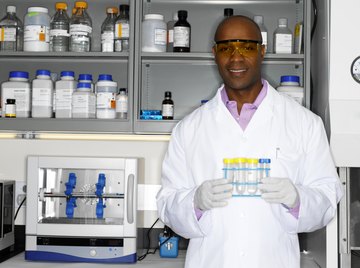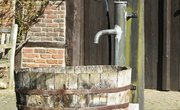
The U.S. Environmental Protection Agency regulates the quality of public water systems across the United States, but does not regulate water quality from private wells. Despite this, owners of private wells can still use the EPA water quality limits for their own guidance, unless their own state has stricter regulations. An annual test for some possible contaminants can help you catch potential problems early, says the EPA, but you need only do a comprehensive analysis every few years. A state certification officer can provide you with a list of approved labs to test the water, and some local health departments may do free or low-cost water testing.
Check that the results show there are no coliforms in your water. Coliforms are bacteria that may have come from animal or human fecal waste. If coliforms are present, the EPA recommends you get another, more specific, test for Escherichia coli, which generally comes from fecal contamination. The presence of any type of coliform means that you should disinfect your water before you can use it.
Compare your nitrate limit to the safe limit of 10 milligrams per liter. This value means that no more than 10 milligrams of nitrates should be in a liter of your well water. If your water contains more than this level, it can produce a condition called methemoglobinemia in infants, which affects their ability to get enough oxygen from the air. Some laboratories prefer to give results in parts per million. Since one milligram per liter is equal to one ppm, then the nitrate safe limit is 10 ppm.
Find the nitrite level for your water. It is at a safe level if it is 1 milligram per liter (1 ppm) or less. Anything higher can also cause methomoglobinemia in infants.
Check that your arsenic and lead levels are not more than 10 micrograms per liter. A microgram per liter may also be represented by 1 part per billion.
Assess the fluoride content of your water. Between 0.6 milligrams per liter and 1.7 milligrams per liter is an adequate level, according to the EPA. Less than this and you won't receive enough fluoride to protect your teeth, and an excess will cause tooth staining. Very high levels, at over 6 milligram intake per day, can also cause skeletal fluorosis, which can lead to fractures.
See if your uranium levels are safe by checking that they are at 20 micrograms per liter or below, because high uranium levels can cause kidney damage. In addition, according to a 2009 study published in "Pediatrics," exposure to uranium at any level, even normal background levels, is a risk factor for cancer.
Judge whether a safe level of radon is in your water by comparing the result against the EPA safe limit of 4,000 picocuries per liter. This measurement is different from the other chemical measurements because the radon is a gas, as opposed to a mineral. Radon in drinking water increases the risk of cancer in an internal organ. Because open drinking water sources like reservoirs or rivers can release radon into the air, enclosed underground sources like wells can have more radon in the water, although it is not present in all underground sources. In addition to ingestion, inhalation of the gas increases lung cancer risk, and radon released into the air from tap water is a potential source.
References
- U.S. Environmental Protection Agency: Is Your Well Water Safe To Drink?
- U.S. Environmental Protection Agency: Frequent Questions
- Water Systems Council: Understanding Drinking Water Test Results
- National Academies Press: Hazard Identification
- U.S. Environmental Protection Agency: Basic Information about Radon in Drinking Water
- Pediatrics: Drinking Water From Private Wells and Risks to Children
About the Author
Jillian O'Keeffe has been a freelance writer since 2009. Her work appears in regional Irish newspapers including "The Connacht Tribune" and the "Sentinel." O'Keeffe has a Master of Arts in journalism from the National University of Ireland, Galway and a Bachelor of Science in microbiology from University College Cork.
Photo Credits
George Doyle/Stockbyte/Getty Images
